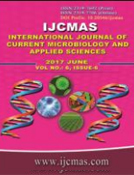


 National Academy of Agricultural Sciences (NAAS)
National Academy of Agricultural Sciences (NAAS)

|
PRINT ISSN : 2319-7692
Online ISSN : 2319-7706 Issues : 12 per year Publisher : Excellent Publishers Email : editorijcmas@gmail.com / submit@ijcmas.com Editor-in-chief: Dr.M.Prakash Index Copernicus ICV 2018: 95.39 NAAS RATING 2020: 5.38 |
Plant extracts from Musa ornate and Zea mays were used for the green synthesis of Copper (Cu) and Zinc oxide (ZnO) nanoparticles (NPs) from copper chloride and zinc sulphate solution respectively. Green synthesized metallic nanoparticles were characterized by UV–visible spectrophotometer, X-ray diffractometer (XRD), Fourier Transform Infra-Red spectrophotometer (FTIR), Scanning Electron Microscope (SEM), Transmission Electron Microscope (TEM), Atomic Force Microscope (AFM) and Zeta potential particle size analyser. Optimum parameters such as precursor salt solution concentration, pH, ratio between reducing agent and precursor salt solution and reaction time, the formation and stability of the reduced metal nanoparticles in the colloidal solution were monitored by UV–visible spectrophotometer analysis. The mean particle diameter of nanoparticles was calculated from the XRD pattern according to the line width of the plane, refraction peak using the Scherrer’s equation. FTIR results suggested that possible biomolecules for the reduction of metallic nanoparticles. SEM and TEM analysis showed the formation of well dispersed metallic nanoparticles and the synthesized metallic nanoparticles were in nano scale range. Antimicrobial activities of the metallic nanoparticles were performed by well diffusion method against Escherichia coli, Staphylococcus aureus, Streptococcus agalactiae and Salmonella enterica. Metallic Cu and ZnO NPs synthesized had antimicrobial activity against pathogenic bacteria and highest antimicrobial activity was found with Cu NPs synthesized using Musa ornate flower sheath against Staphylococcus agalactiae.
 |
 |
 |
 |
 |